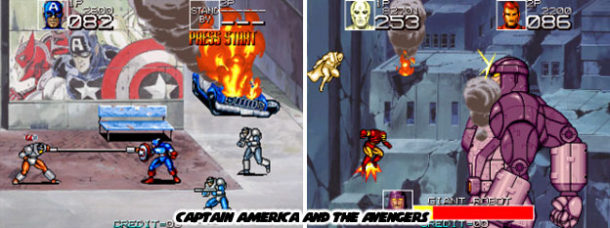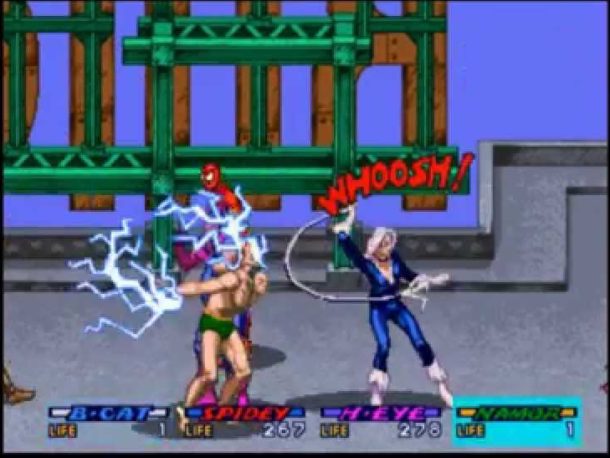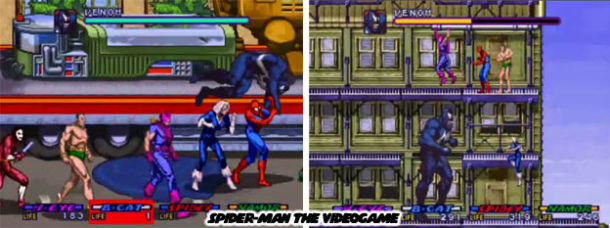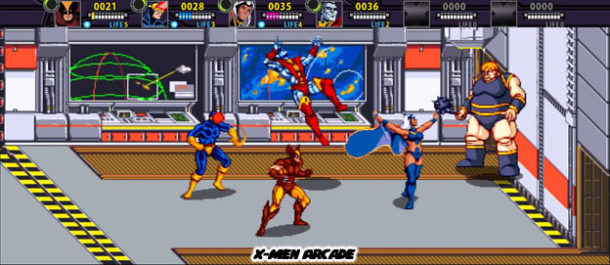The start of the new decade, 1991, was a gold rush. Every arcade company wanted to make their fortune on a brawler. Data East saw the runaway success that Konami enjoyed with their licensed titles and decided to secure a high profile Western license for themselves as well. The result, Captain America and the Avengers, was without a doubt the biggest quarter-waster my brothers and I had the misfortune of playing.

The game featured Captain America, Iron Man, Vision and Hawkeye taking on the Red Skull and a collection of villains from Marvel Comics. Unfortunately the people at Marvel seemed to have little creative control once they signed up with Data East. The game played as if the Japanese developers flipped through some comic books in the lobby of Marvel studios and then never looked at them again. The character sprites were small and not detailed, possibly so players in the USA would not be offended by the gross disregard to the legendary designs. Playing as the characters was fun, I am not going to lie about that. Each character had ranged attacks and close up strikes. The first time I threw Captain America’s shield into the head of a robot and watched it bounce back to me I was quite giddy. I’ve enjoyed almost all of Data East’s arcade releases however this game left me disappointed.

The game ate quarters like mad. Every strike from rivals seemed to eat up health at an alarming rate. Quite honestly it probably ate quarters faster than P.O.W. Back then SNK had an excuse, the genre was just getting started. The line between difficulty for the sake of challenge and difficulty for the sake or ripping off players hadn’t been established yet. Data East had no excuse. Once they were out of health the characters would drop to their knees and exclaim “I can’t move…” at which point my brothers and I would yell out “Feed me another quarter!” The more time I spend talking about this game the more disappointed I get. So let’s move instead to another company that released a Marvel brawler later that year.
As 1991 was ending Sega was getting back aboard the arcade brawling bandwagon. Their last effort, Golden Axe, was met with favorable reviews. They studied the trends and were looking for a way to break the monopoly that Konami and Capcom were building. Sega was putting the finishing touches on their new arcade hardware, the System 32, which they felt was a powerful enough graphics engine to differentiate their next title from anything else out there. To show off their new processing power the first thing they did was secure a high profile license. They went to Marvel Comics and managed to get the license for Spider-Man. It was a surprise to me that Marvel would trust another Japanese developer following the debacle of Data East’s Captain America game. What was even more surprising was that Sega had once gotten a cease and desist from Marvel because the original Shinobi featured a wall crawling ninja wearing red and blue tights at the end of Level 1 (1:13 in) that looked an awful lot like Spider-Man.
Anyhow, the Sega game was a 4-player title featuring Spider-Man, the Black Cat, Namor the Submariner and Hawkeye. Unlike the hack job that was Captain America the developers seemed to have done research on the Marvel Universe and then went above and beyond in trying to recreate the western comic book format for arcades. The game was actually designed to reflect the pages of Marvel comics Characters would speak in word balloons, even during the fighting sequences. Level cinemas would play out in the panel per panel format. There was a certain gritty aesthetic to the visuals, as if it were a traditional 4-color traditional comic book come to life. The characters appeared to have been colored and even inked using traditional methods instead of strictly digitally. Proportionally there was something odd about the characters. They appeared as if a Japanese artist used to the manga format were trying their best to draw in the western style. The nuances of the poses, muscles and frames for the characters was slightly off compared to the actual Marvel model sheets. Not that it mattered, Sega released a game that was part brawler and part side-scrolling adventure.

The new graphics engine they created could scale the sprites with very little loss in fidelity. Sega used this to zoom out of action sequences and allow all four players to be seen climbing buildings, castles or going through caves independently. It was a groundbreaking gameplay and visual element.

The game was fun if a bit hard. Unlike the Captain America game I didn’t mind putting quarters in this title. I’m not sure if it was a rare title but of all the arcades I visited in my youth I only saw two Spider-Man cabinets. Perhaps this lack of exposure was why the game was rarely mentioned in comic book to videogame comparisons.
Konami had a higher profile release with the six-player X-Men arcade game. The deluxe version of the cabinet was pure excess but could actually be found at several arcades I frequented. It was two oversized screens wide and featured a dedicated joystick and buttons for the individual characters. The massive cabinet was about as big as three regular cabinets stacked side by side. The wraparound art featuring full color graphics from the Marvel artists themselves was a statement to the industry as much as to gamers. Konami had declared themselves the all-time king of the brawler (and of licenses too).

The game had a certain anime stylization rather than the comic format from Sega. This was because the 1992 brawler was based on an animated pilot from 1989. The Pryde of the X-Men was Marvel’s first attempt at getting an X-Men animated series off the ground. It was produced by the Japanese Toei animation studios. That was the same studio that worked on other iconic shows from the 80’s including GI Joe, JEM and the Holograms and the Transformers.
My brothers and I loved the pilot episode and wished that a series would have been made from it. The quality of the designs and animation were much better than the Fox Kids! series that appeared a few years later. But I digress…
The game itself pulled the locations and character designs right from the animated pilot. Each of the X-Men had a special, screen clearing attack based on their powers. For example, Storm could summon a series of whirlwinds and Nightcrawler could zap across the screen with his teleporting powers. Other powers, like Colossus’ energy field were made up by the game designers, but this discrepancy was overlooked by most fans because the game was tremendous fun. It worked well with a single player but was best experienced when all six characters were on screen fighting off waves of robots, sentries and lizard men. The title was difficult as were the other Konami arcade brawlers and like those experiences the last level featured a battle royale against all of the previously defeated bosses.

Next month, Marvel v. Capcom previews at E3. I hope to get my hands on it and get some playthrough video. It’s always nice to see another Marvel brawler. Let’s hope they do it right. At least I won’t be running out of quarters anymore. My wife Shelly, on the other hand, prefers the mobile game Marvel Tournament of Champions, which is also a brawler. She says it’s the only brawler she’s been able to win.


You must be logged in to post a comment.